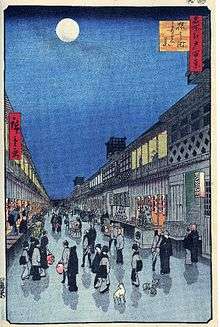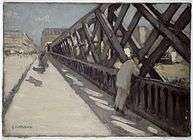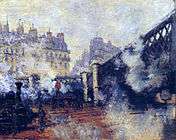Le Pont de l'Europe
| English: The Europe Bridge | |
 | |
| Artist | Gustave Caillebotte |
|---|---|
| Year | 1876 |
| Medium | Oil on canvas |
| Dimensions | 125 cm × 181 cm (49 in × 71 in) |
| Location | Musée du Petit Palais, Geneva |
Le Pont de l'Europe (English title: The Europe Bridge) is an oil painting by French impressionist Gustave Caillebotte completed in 1876. It is held by the Musée du Petit Palais in Geneva, Switzerland. The finished canvas measures 125 by 181 centimetres (49 in × 71 in).[1]
Description
The image shows pedestrians in the Place de l'Europe in the 8th arrondissement of Paris. The plaza is a large bridge joining six avenues, each named for a European capital, over the railroad yards at Gare Saint-Lazare. The view is from the rue de Vienne, looking towards the center of the plaza.[2] One of the bridge's trusses is very prominent, visible in half of the image.
Three individuals are seen in the foreground: a couple walking toward the observer, and a working-class man peering off the bridge toward the train station. A dog walks away from the observer, and other individuals appear in the mid-background. The man of the couple is a flâneur, an upper-class street observer. He is strolling with a woman dressed in black. She has often been interpreted to be a prostitute, according to contemporary social norms regarding women in public, especially in the area of the train station.[3] Alternatively, the man has been thought to be Caillebotte himself, and the woman to be Caillebotte's companion, Anne-Marie Hagen.[4] The flâneur is looking past his companion in the direction of the other man. Feminist art historian Norma Broude has suggested that Caillebotte, a lifelong bachelor, is signalling his own homosexuality with this gaze. In this reading, Caillebotte is an upper-class man cruising for a lower-class male prostitute in this unsavory neighborhood of Paris.[5] However, Caillebotte's sexual orientation is not definitively known.[6]
Caillebotte displayed this image at the impressionist exhibition of 1877, alongside his Rue de Paris, temps de pluie and Claude Monet's Le Pont de l'Europe, Gare Saint-Lazare, which gives an alternate view of the bridge.[7]
Caillebotte, as in many of his works, employs perspective. The vanishing point is located behind the head of the man, which is far to the side of the picture, creating oblique perspective.[8] Caillebotte was influenced by Japanese art, especially the work of Hiroshige, and by photography, then a burgeoning artistic field.[9] In turn, this painted composition may have been an influence in photographer Jeff Wall's work from 1982, Mimic, which features similar exaggerated perspective and class tension between the three similarly situated characters.[10]
Caillebotte’s The Europe Bridge shows how obeying the rules of society can work: the social classes indeed coexist, they meet each other on the streets, but they do not correlate. Hausmann’s spacious boulevards allow such state of things. Paris won’t ever come back to its Medieval past. [11]

Gallery
-

Sketch 1876, Musée des beaux-arts de Rennes[1]
-

Oil sketch, c. 1876
-

Sur le Pont de l'Europe (1877)
Kimbell Art Museum -

Claude Monet, Le Pont de l'Europe, Gare Saint-Lazare, 1877, Musée Marmottan
Notes
- ↑ Varnedoe 2002, p. 72.
- ↑ Varnedoe 2002, p. 9.
- ↑ Rubin 2003, p. 103.
- ↑ "Lot notes, La femme à la rose". Christies.com. 8 November 2012. Retrieved 3 March 2013.
- ↑ Broude 2002, p. 130.
- ↑ Langford 2007, p. 173.
- ↑ Herbert 1991, p. 24.
- ↑ Varnedoe 2002, p. 31.
- ↑ Varnedoe 2002, p. 24.
- ↑ Langford 2007, p. 172.
- ↑ Clark, T.J., The Painting of Modern Life. Paris in the arty of Monet and his Followers. Princeton, New Jersey: Princeton University Press, 1984
References
- Broude, Norma (2002). Gustave Caillebotte and the Fashioning of Identity in Impressionist Paris. Rutgers University Press. ISBN 0813530180.
- Herbert, Robert L. (1991). Impressionism: Art, Leisure, and Parisian Society. Yale University Press. p. 312. ISBN 0300050836.
- Langford, Martha (2007). Scissors, Paper, Stone: Expressions of Memory in Contemporary Photographic Art. McGill-Queen's Press. p. 367. ISBN 0773532110.
- Rubin, James (2003). Impressionist Cats & Dogs: Pets in the Painting of Modern Life. Yale University Press. p. 144. ISBN 0300098731.
- Varnedoe, Kirk (2000). Gustave Caillebotte. Yale University Press. ISBN 9780300082791.
- Varnedoe, Kirk (2002) [1974]. "Caillebotte's Le Pont de l'Europe: A New Slant". In Broude, Norma. Gustave Caillebotte and the Fashioning of Identity in Impressionist Paris. Rutgers University Press. ISBN 0813530180.